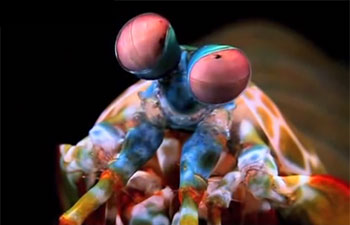
Wikimedia Commons
The bulls have been lying to you. They’re colour blind and it wouldn’t even matter if the matador’s cape was baby pink. What they’re actually reacting to is the movement of the cape.
Dogs, cats, mice, rats and rabbits also have pretty lousy colour vision too. They see mostly greys and some blues and yellows.
The number of different colours a species can distinguish depends on how many types of colour receptors they have. Humans have 3 (red, green, blue) whereas most mammals have only 2 (red and green receptor cones). So humans can see hundreds of thousands of hues that are invisible to dogs or horses. That’s why you don’t see too many of them at art exhibits.
Human colour vision stretches from long wavelengths we see as red, to the shorter wavelengths we see as violet. Ultraviolet vision, however, is fairly common among insects, fish, reptiles and birds. Imagine what would happen if we had a fourth receptor. No work would get done because everybody would be staring at random things, thinking “look at all the pretty colours.” There would be thousands of more hues visible to us.
Birds, of course, don’t just have this ultra-vision because it’s a cool thing to tell their mammal buddies about. Ultraviolet (UV) vision aids birds in detecting prey; their keen vision lets them see traces of their prey’s faeces and urine. They also use it to get some birdy-action, identifying potential mates with their perception of the plumage using UV light reception. They also utilise it for migration purposes on over-cast days because the sun’s UV rays pass through cloud cover.
Butterflies’ and honey bee’s sensitivity to light helps them search for their food. They see shades of flowers differently, which helps guide them to the exact location of nectar. They also identify each other with special markings on the wings only visible in UV light.
Snakes such as boa constrictors and pit vipers use infrared to see their prey. Infrared is useful by some species of fish, such as piranha and goldfish. In murky waters, longer infrared rays can go further in the water than shorter rays of the colour spectrum, which can get broken and diffused.
Mosquitoes primarily use sight and smell until they get within 10 feet of their prey, at which point heat vision takes over.
But the winner…
…of the most photoreceptors goes to the Mantis Shrimp! (Give them a big hand ladies and gentlemen). This superhero of sight can have 12 different photoreceptor types, each sampling a narrow set of wavelengths ranging from deep ultraviolet to far red.
It can look at a rainbow and feel like it’s on LSD. Not that we know what that’s like. We don’t.
Think About It
What does this say about beauty as we see it? When we see a fantastic sunset, butterflies might be something absolutely different.
Do birds see paintings differently? Are they absorbing critical nuances and details that we don’t? Would they look at the same Mona Lisa and observe a UV element to it?

Monet joins the x-men: The painter Monet may have started seeing UV after a cataract operation at age 82, influencing his famous series of water lily pictures.
We certainly don’t have the best set of eyes, having our world governed by 3 cones. And all we can do is speculate how other species view our world. Beauty does really lie in the cones of the beholder.
Learn More
- This Radiolab show explains colours seen by different animals (including our champ shrimp) via a choir
- Nautlius has a slick slider to see the difference between what we see and what different animals do
- And for an even more interactive and animated version of this see this 3d simulation of all eyes on paris!
- The dung beetle’s retina is inspiring night vision cameras by car companies
- Also inspired by the 360-degree vision of a fly and the independently moving eyes of a chameleon, inventors at the ESIEA engineering school in Paris, France have developed “FlyVIZ“
About the Authors
Nash hopes to help open minds to the wondrous stories that exist all around. He’s a freelance graphic and web designer.
Jonathan Dias freelances for magazines and papers like Maxim and the Herald, writing about women, food and gadgets. He is also attempting to write a cook book that involves a lot of bacon and beer.



